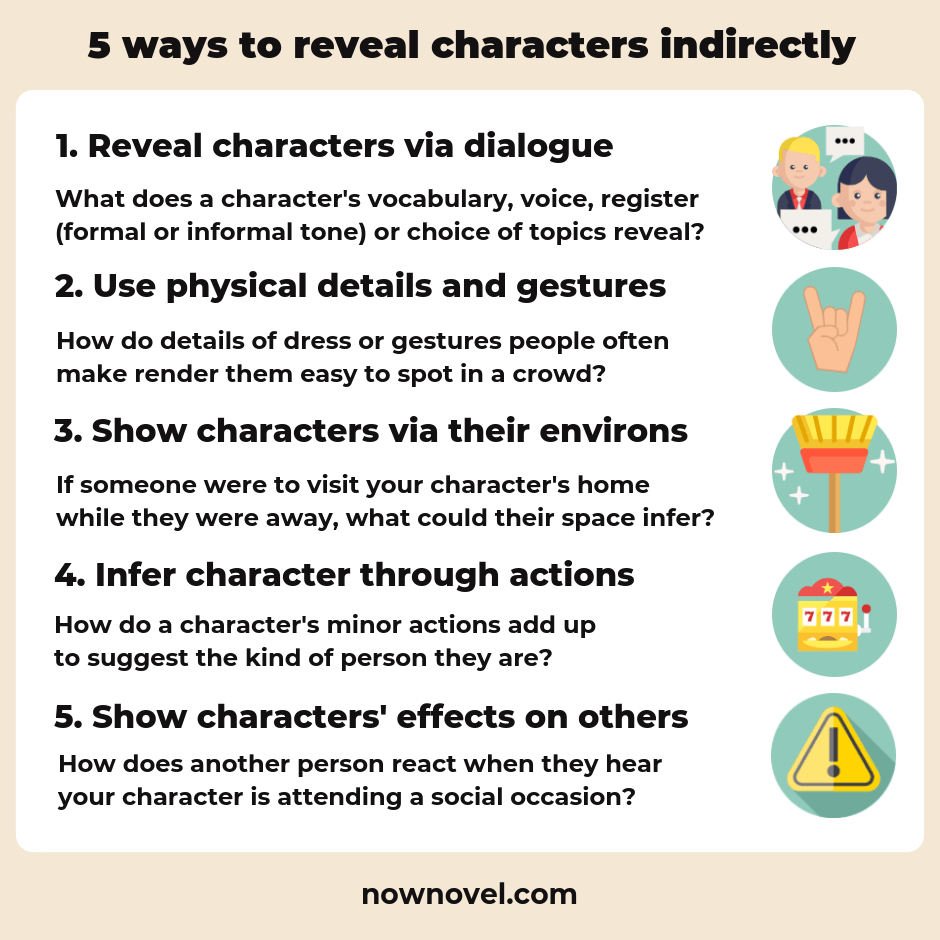Indirect characterization is writing that paints in character detail by showing rather than telling. Rather than only tell readers about characters’ personalities and values, you can reveal them subtly through dialogue, actions and appearances. Read these tips and examples:
1. Use illustrative dialogue for indirect characterization
The way characters talk (in addition to what they say) gives useful indirect characterization.
For example, in Donna Tartt’s The Goldfinch (2013), Tartt uses indirect characterization in dialogue to show Theo Decker’s mother’s passion for art. We read this as the two wander through an exhibition at the Metropolitan Museum of Art:
“I like this one too,” whispered my mother, coming up alongside me at a smallish and particularly haunting still life […] “They really knew how to work this edge, the Dutch painters – ripeness sliding into rot. The fruit’s perfect but it won’t last, it’s about to go. And see here especially,” she said, reaching over my shoulder to trace the air with her finger, “this passage – the butterfly.”
Donna Tartt, The Goldfinch (2013), p. 25
Theo’s mother studied art history. Tartt shows her background and passion through dialogue. This creates a deeper impression than if Tartt were to simply write, ‘Theo’s mother studied art history and was passionate about Dutch painters.’
As Tartt does, when using dialogue for indirect characterization:
- Distinguish characters: Theo’s mother rattles off art history and ideas about the paintings. Theo, on the other hand, responds simply (e.g. ‘How long did it take him to paint that?’) The differences in their knowledge and passion for the subject are clear
- Use voice and gesture: Theo’s mother whispering shows her respect for the museum setting or reverence for the art. Her gesturing in the air and tracing the key features in paintings as she talks shows her broad passion and knowledge.
Our 4-week dialogue-writing course will teach you how to write stronger illustrative dialogue. Learn more here.
2: Show characters through descriptive details
Physical description is also a useful tool for indirect characterization.
Think of characteristic gestures. A sassy person, for example, who snaps their fingers when disagreeing with a friend:
"Excuse me?" She snapped her fingers, arm crooked.
Although gestures such as these can seem stereotypical, if you use them sparingly they help to show your characters’ temperaments.
Example of using dress for indirect characterization: The Marriage Plot
Consider this example of indirect characterization from Jeffrey Eugenides’ The Marriage Plot (2011). Eugenides describes student Mitchell’s professor, Richter:
Mitchell had never had a professor like Richter before. Richter dressed like a banker. He wore gray chalk-striped suits, conservative ties, button-down shirts, and polished brogues. […] His voice was low, Kissingerian, minus the accent. It was impossible to imagine him as a boy.
Jeffrey Eugenides, The Marriage Plot (2011), p. 95
The fact Richter dresses like a banker and it’s ‘impossible to imagine him as a boy’ suggests seriousness. We get the impression Richter is old-fashioned and fastidious from his dress.
Compare Eugenides description to a professor described as unkempt and slovenly. What would we assume in this case? Perhaps that the professor is eccentric, or never on time. Think about how details such as someone’s dress or voice colour our perception of their character.

3: Use a character’s home turf to reveal more about them
Setting is also a useful tool for creating indirect characterization.
A person’s home, school locker, or office can reveal a lot about them. Let’s return to Eugenides’ campus novel, The Marriage Plot. When Mitchell is summoned to his banker-like professor’s office, we read this description:
Richter’s office was formal, almost Viennese. There were glass-fronted bookcases full of leather-bound theology books, an ivory-handled magnifying glass, a brass inkstand. The desk was massive, a bulwark against the creeping ignorance and imprecision of the world. Behind it, Richter was writing notes with a fountain pen.
Eugenides, The Marriage Plot, p. 97
This setting description reveals more about Richter. The description of the desk is especially revealing. The size makes it seem like a fortress against modern life and its ‘creeping ignorance and imprecision’. Richter’s choice of writing instrument – a fountain pen – again suggests refinement and old-fashioned qualities in Richter himself.
When describing a character’s home turf, be it an office, a house or another place they inhabit, consider:
- How the setting gives away their personality: How might an eccentric artist’s home be decorated versus the home of a chic personal stylist? What is its atmosphere and mood?
- How other characters interpret the setting The details Mitchell notices about his professor’s office confirm his impressions that Richter is old-fashioned.
4: Use actions to show important character traits
Imagine you wanted to introduce a character who has high levels of anxiety in your story. You could write ‘she was an anxious person’. Yet this spells out the character a little. It isn’t a visual, evocative portrait.
Now consider this example from Dostoevsky’s Crime and Punishment (1866):
Katerina Ivanovna had just begun, as she always did at every free moment, walking to and fro in her little room from window to stove and back again, with her arms folded across her chest, talking to herself and coughing.
Fyodor Dostoevsky, Crime and Punishment (1866), p. 162
This is a much more compelling description of anxiety, and shows both Katerina’s angst and ceaseless energy. Even though the character has terminal tuberculosis, her concern for her family causes her to exert more energy than she has spare. When her husband Marmeledov, a disgraced civil servant and alcoholic is killed in a carriage accident, Katerina takes to the streets with her children, making them sing and dance for money.
Through Katerina's pacing and her frenzied, tragic activity with her children, Dostoevsky indirectly reveals her anxiety, fierce will to survive and, ultimately, desperation.

5: Show characters’ effects on others
It is important, of course, to balance indirect characterization with its direct counterpart.
Sometimes, it’s simplest and quickest to just say ‘she stayed up late worrying’ or ‘he was a suave charmer’.
Another way to use indirect characterization, however, is to show characters’ effect on others. For example, if a character is ingratiating to another, addressing them as ‘sir’ or ‘my lord’, this immediately suggests the other character has higher power or status. Along comes a character who neglects to use these titles - this suggests a more equal footing.
If a hush falls over a room upon a character’s entrance it could suggest awe (at their person or appearance). It could also suggest terror (if the arriving character is powerful and cruel.
For example, in Margaret Atwood’s The Handmaid’s Tale (1985), Atwood shows the fear-inducing effects of a narrowly-controlled society. Her protagonist Offred and others initially respond to authority figures meekly. By showing the effect of the powerful on those who, like Offred, have been turned into mere ‘national resources’, Atwood creates a sense of vanishing freedom in her dystopian setting.
Here, for example, her main character is listening to the character Aunt Lydia speak:
Here her voice broke off, and there was a pause, during which I could hear a sigh from those around me. It was a bad idea to rustle or fidget during these pauses. Aunt Lydia might look abstracted but she was aware of every twitch.
Margaret Atwood, The Handmaid's Tale, p. 56
This alertness to social boundaries in Offred prepares us for revelations about how women’s lives are controlled and administered in Atwood’s world. Through indirect characterization we realize characters' caution under constant threat of punishment for disobedience.
Similarly, use indirect characterization in character’s reactions to each other to show their feelings. For example, how might a high school student react when their crush enters the room?
Improve your character descriptions: get How to Write Real Characters: Character description, a concise guide including checklists, exercises and helpful videos.










This one is great. Trouble is, it doesn't set out its parameters, it's stall,from the off. Its predicated on the writing of a novel, nothing more,nothing less. A lie of omission maintains its status as a lie.
Shay Reilly - Over 7 years ago